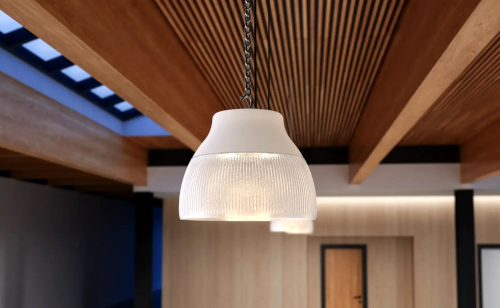Signify unveils high bay printed with bio plastics

Signify has unveiled a prismatic-style high bay luminaire that’s 3D printed using either recycled or ‘bio-circular’ plastics.
The Highlight – from the myCreation additive manufacturing division – is printed on demand for customers and is highly personalisable in terms of shape and colours.
It has an efficacy of 196 lm/W and, says the company, produce less carbon emissions when compared to traditional, conventional luminaires. The Highlight has a rated life of 100,000 hours to L80 at an ambient temperature of 25 degrees Celsius. It’s glow-wire tested to 850 degrees Celsius and rated with an ingress protection of IP65 and impact resistance of IK02.
Signify has been a pioneer in the additive manufacturing arena in terms of scale. It has supplied major clients such as UK retail giant Marks & Spencer and McDonald’s restaurants.
At least 55 per cent of the Essential series is made from materials derived from waste and residues of biological origin from agriculture, forestry and related industries, such as tall oil from the wood processing industry and used cooking oil.
Signify stresses that the materials are thus not made from crude oil but from natural sources.
It says that the entire supply chain from the granulate supplier to the filament and luminaire production is certified by the International Sustainability and Carbon Certification,an independent certification system supporting climate-friendly supply chains.
The Essential range – 3D printed at Signify’s factory in Turnhout, Belgium – is available in three sizes and can be mounted in three different ways.
Signify 3D printing facilities are also operational in the United States of America at Burlington, Massachusetts, serving both professional and consumer markets.
One of the key advantages of 3D printing in luminaire production is the flexibility it offers in terms of design. Traditional manufacturing methods often impose limitations on intricate and complex designs, but 3D printing allows for the creation of highly detailed and intricate structures that were once deemed impossible.
• Learn more about sustainable and wildlife-friendly lighting at Circular Lighting Live 2025, Recolight’s flagship conference and exhibition, which takes place on Thursday 25 September 2025 at the Minster Building in the City of London. Free to specifiers, Circular Lighting Live 2025 will feature leading experts, specifiers and policy makers who will share their insights into forthcoming standards and legislation, emerging technologies and new business models. More info: www.circularlighting.live


